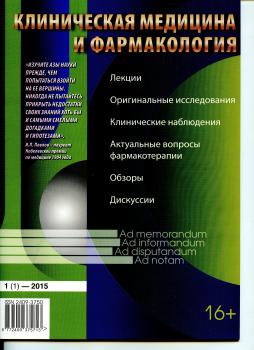Tula, Russian Federation
As you know, from ancient times to the present day, an individual approach to the patient has been and remains the most relevant in the framework of diagnosis, treatment and prevention of disease. In the modern world, the use of this approach is called personalized medicine, that is, "a rapidly developing field of healthcare based on an integrated, coordinated and individual approach for each patient to analyze the occurrence and course of the disease." From the foregoing, it becomes apparent that taking into account the constitutional features of the patient in the framework of anthropological teaching is an integral component in the supervision of each specific patient. A considerable number of facts accumulated in modern literature, indicates the constitutional conditionality of the parameters of the human body at different levels. It is this approach in the study of a macroorganism that allows one to get a more complete picture of not only the whole variety of forms and factors of system variability, but also to reveal patterns between the individual somatic constitution of a person, that is, a somatotype, and its other systems, in particular the digestive system. In the development of chronic gastroduodenitis, the hereditary-constitutional factor is one of the most important.
constitution types, chronic gastroduodenitis, Helicobacter pylori, asthenic, normosthenic, hypersthenic.
1. Balko O. A., Sapozhnikov V. G. O metodah diagnostiki hronicheskogo gastroduodenita, associirovannogo s Helicobacter pylori, v zavisimosti ot tipa konstitucii (obzor literatury) // Vestnik novyh medicinskih tehnologiy. 2019. №2 (26). S. 5-11.
2. Boboshko I. E. Harakteristika psihosomaticheskogo statusa detey trehletnego vozrasta: avtoref. dis. kand. med. nauk. Ivanovo, 2001. 20 s.
3. Gorbunov N. S., Cukanov V. V., Tokarev A. V. Konstitucional'nye osobennosti vzaimodeystviya Helicobacter pylori i organizma cheloveka // Sibirskoe medicinskoe obozrenie. 2002. №4. S. 21-26
4. Grigorovich M. A. Sekretornaya funkciya i morfologicheskie osobennosti slizistoy obolochki zheludka u lyudey raznyh tipov teloslozheniya: avtoref. dis. kand. biol. nauk. Chelyabinsk, 2003. 23 s.
5. Dombayan S. H., Panova I. V. Osobennosti izmeneniya urovnya neyronspecificheskoy enolazy u detey I-II gruppy zdorov'ya v zavisimosti ot pokazateley fizicheskogo razvitiya i pola // Vrach-aspirant. 2016. №2.2 (75). S. 273-278.
6. Zhdanova L. A. Sistemnaya deyatel'nost' organizma rebenka pri adaptacii k shkol'nomu obucheniyu : avtoref. dis. dokt. med. nauk. M., 1990. 41 s.
7. Zhetimkarinov D. S. Hirurgicheskaya anatomiya svyazochnogo apparata zheludka i ego prikladnoe znachenie: avtoref. dis. kand. med. nauk. Alma-Ata, 1975. 25 s
8. Zaprudnov A. M., Grigor'ev K. I., Haritonova L. A. i dr. Problemy i perspektivy sovremennoy detskoy gastroenterologii // Pediatriya. Zhurnal im. G.N.Speranskogo. 2016. №6 (95). S. 10-18.
9. Zilov V. G., Hadarcev A. A., Es'kov V. M. i dr. Novyy effekt v fiziologii nervno-myshechnoy sistemy cheloveka // Byulleten' eksperimental'noy biologii i mediciny. 2019. №4 (167). S. 400-404.
10. Isaeva G. Sh. Problemy sovershenstvovaniya diagnostiki Helicobacter pylori infekcii // Kazanskiy medicinskiy zhurnal. 2011. №2. S. 257-261
11. Luneva E. V. Osobennosti pitaniya i nekotorye pokazateli obmena belkov i zhirov u studentov raznyh tipov teloslozheniya: avtoref. dis. kand. biol. nauk. Chelyabinsk, 2007. 22 s.
12. Maksimenkov A. N. Hirurgicheskaya anatomiya zhivota. M: Ripol Klassik, 1998. 688 s.
13. Salova M. N. Sostoyanie zdorov'ya detey 9-11 let s posledstviyami perinatal'nogo porazheniya central'noy nervnoy sistemy s uchetom tipa ih psihosomaticheskoy konstitucii: avtoref. dis. kand. med. nauk. Ivanovo, 2009. 28 s.
14. Sapozhnikov V. G. Ehografiya zheludka i dvenadcatiperstnoy kishki u detey (obzor literatury, kratkiy) // Vestnik novyh medicinskih tehnologiy. Elektronnoe izdanie. 2013. №1. S. 169.
15. Cherednikov E. F., Maleev Yu. V., Chernyh A. V. i dr. Sovremennye vzglyady na diagnostiku, lechenie i profilaktiku razryvno-gemorragicheskogo sindroma (sindroma Mellori-Veyssa) // Vestnik novyh medicinskih tehnologiy. 2016. №4. S. 161-172.
16. Shamsutdinova R. A., Chepurnyh A. Ya., Savinyh E. A. i dr. Inficirovanie Helicobacter pylori: metody diagnostiki // Vyatskiy medicinskiy vestnik. 2012. №4. S. 61-68.
17. Shishko V. I., Petrulevich Yu. Ya. Gastroezofageal'naya reflyuksnaya bolezn': anatomo-fiziologicheskie osobennosti pischevoda, faktory riska i mehanizmy razvitiya (obzor literatury, chast' 1) // Zhurnal GrGMU. 2015. №1 (49). S. 19-25.
18. Shorova T. V. Konstituciya cheloveka i hronicheskie zabolevaniya vnutrennih organov. M.: Izdatel'stvo Moskovskogo universiteta, 1989. S. 109-125.
19. Yuhimenko Zh. V. Konstitucional'nye osobennosti techeniya zabolevaniy verhnih otdelov pischevaritel'nogo trakta i ih profilaktika u detey 5-9 let: dis. kand. med. nauk. Ivanovo, 2010. 187 s.
20. Yanushevich O. O., Maev I. V., Samsonov A. A. i dr. Dyhatel'nye testy v diagnostike Helicobacter pylori // Zdorov'e i obrazovanie v XXI veke. 2013. № 1-4. S. 253-258.
21. Gillett P., Hassall E. Pediatric gastrointestinal mucosal biopsy. Special considerations in children // Gastrointestinal Endoscopy Clinics of North America. 2000. Vol.10. P. 669-640.
22. Kassem E., Naamna M., Mawassy K.. Helicobacter pylori infection, serum pepsinogens, and pediatric abdominal pain: a pilot study // European Journal of Pediatrics. 2017. Vol.176. P. 1099-1105.
23. Kori M., Daugule I., Urbonas V. Helicobacter pylori and some aspects of gut microbiota in children // Helicobcter. 2018. Vol.23. P. 1-8.
24. Yamaoka Y. Mechanisms of disease: Helicobacter pylori virulence factors // Naturel Reviews Gastroenterology & Hepatology. 2010. №7(11). S. 629-641.








